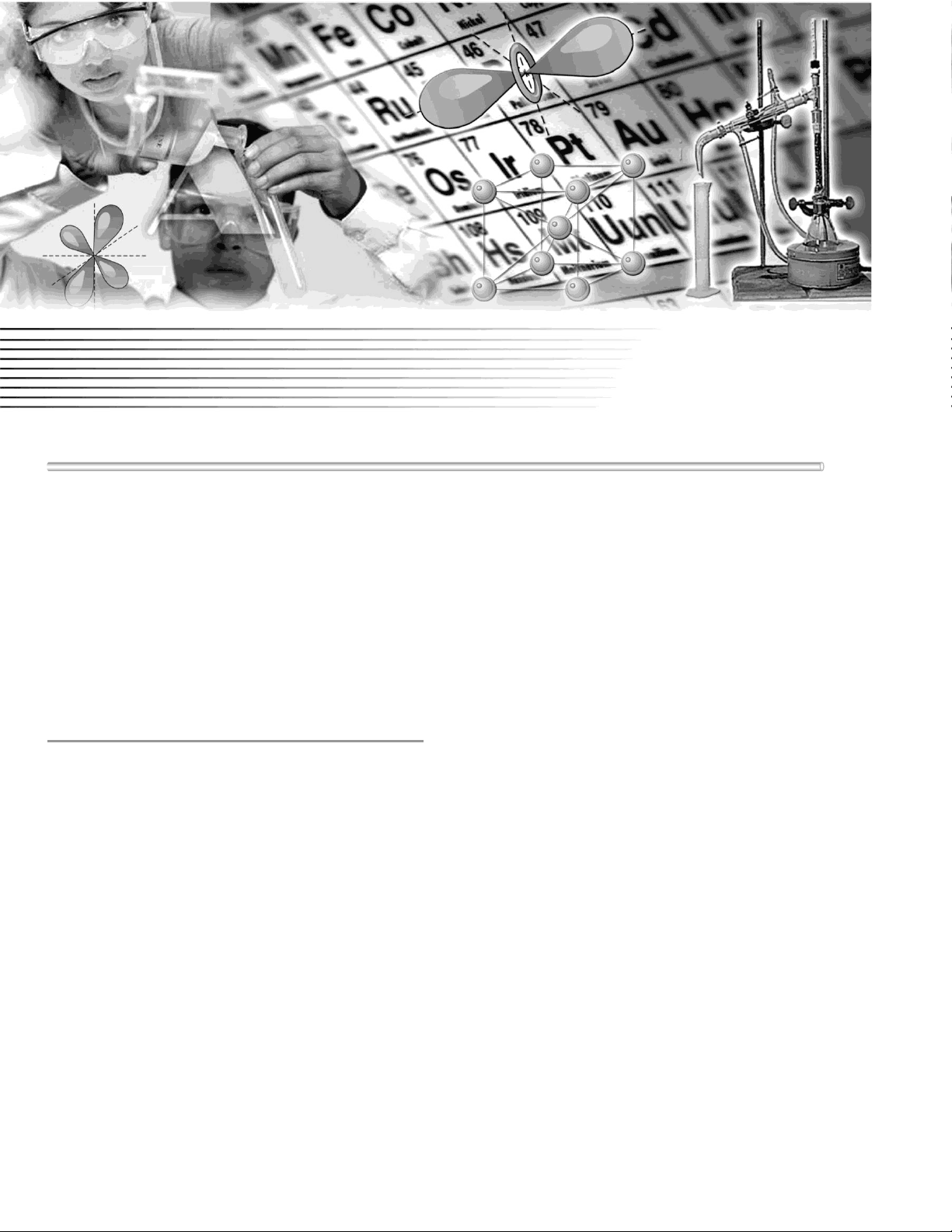
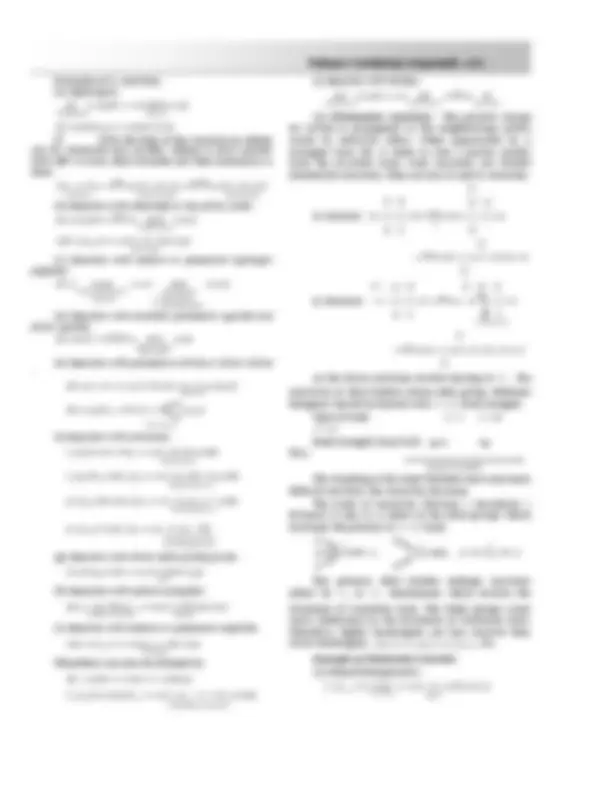
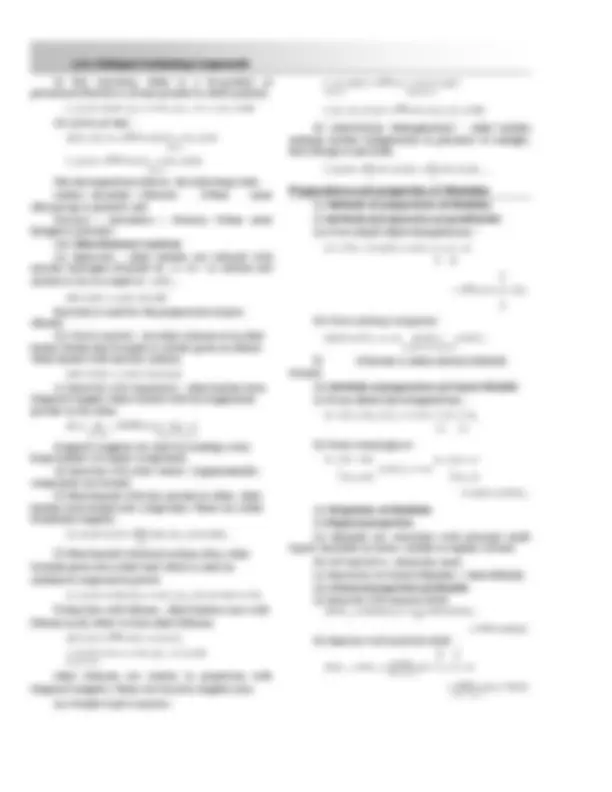
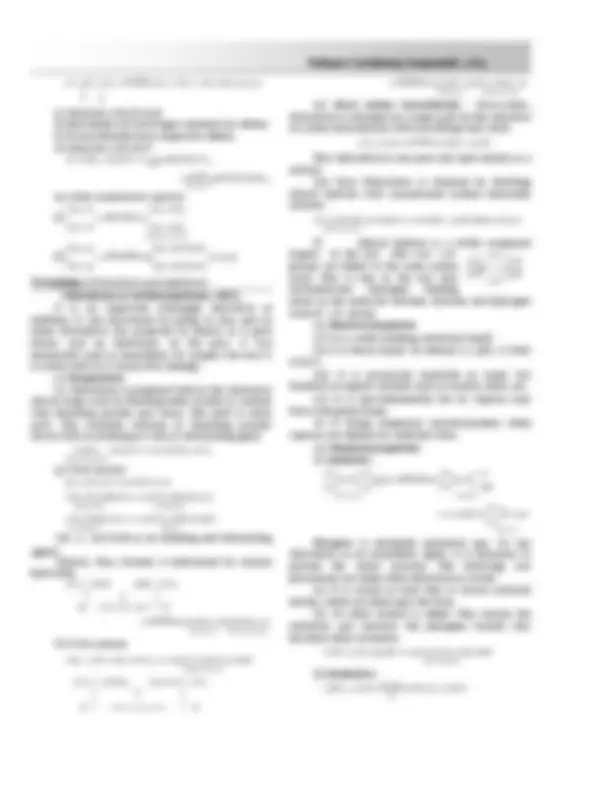
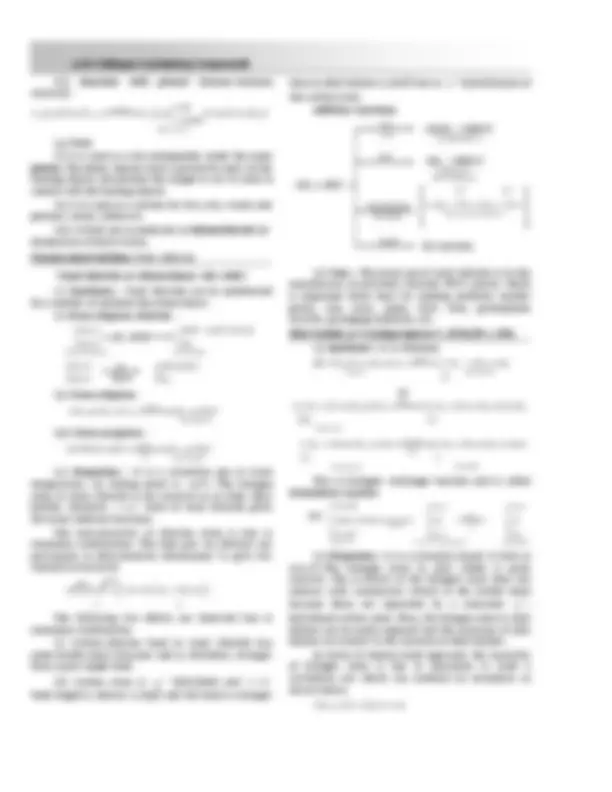
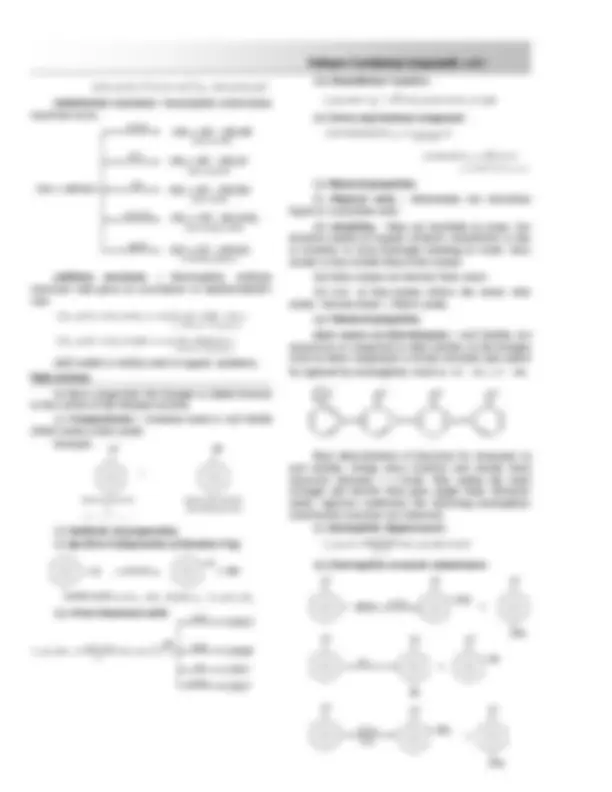
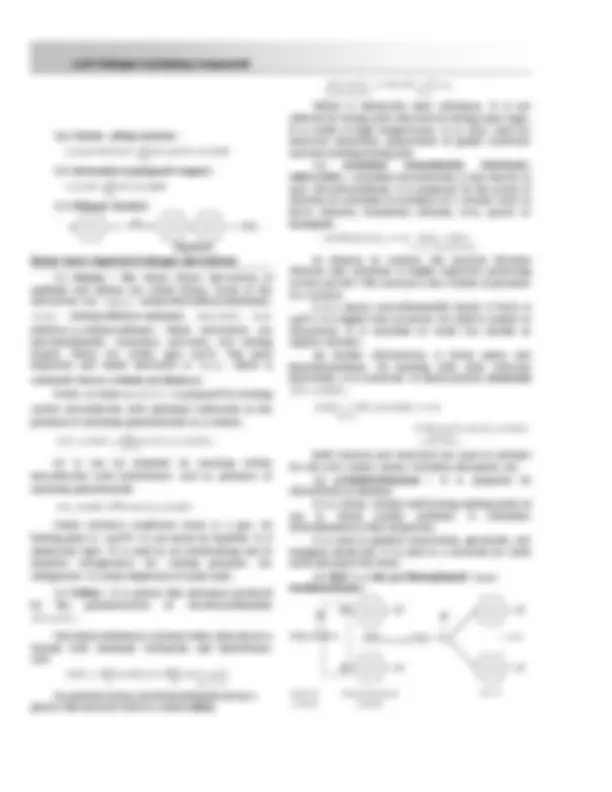



Study with the several resources on Docsity

Earn points by helping other students or get them with a premium plan


Prepare for your exams
Study with the several resources on Docsity

Earn points to download
Earn points by helping other students or get them with a premium plan
Community
Ask the community for help and clear up your study doubts
Discover the best universities in your country according to Docsity users
Free resources
Download our free guides on studying techniques, anxiety management strategies, and thesis advice from Docsity tutors
Simple and lucid explanation of the topic with diagrams, tables, tips etc.
Typology: Study notes
1 / 13

This page cannot be seen from the preview
Don't miss anything!








Compounds derived from hydrocarbons by the replacement of one or more hydrogen atoms by the corresponding number of halogen atoms are termed as halogen derivatives. The halogen derivatives of the hydrocarbons are broadly classified into three classes: Halogen derivatives of saturated hydrocarbons (Alkanes)- Halo-alkanes. Halogen derivatives of unsaturated hydrocarbons (Alkenes and alkynes)-Halo-alkene or alkyne. Halogen derivatives of aromatic hydrocarbons (Arenes)-Halo-arenes.
(1) From alkanes (i) By halogenation :
Ethane^2
CH (Excess) + Cl hv ^ CHCl HCl (^2) Ethylchloride 2 (Major (^5) product)
2 - Chloropropane(55%)
(^3) Propane (^2 3) light 1 Chloroprop (^32) ane(45%) (^23) | 3 2 Cl
CH CHCH UV Cl ^ CHCHCHCl CHCHCH
This reaction proceed through free radical mechanism. Order of reactivity of (^) X 2 for a given alkane is, F 2 (^) Cl 2 Br 2 I 2.
The reactivity of the alkanes follows the order : 3°alkane > 2°alkane > 1°alkane. (ii) With sulphuryl chloride : R H SO 2 Cl (^2) Organic (^) peroxide hv^ ( R CO ) R Cl SO 2 HCl 22
This reaction is a fast due to in presence of light and trace of an organic peroxide. (2) From alkenes (Hydrohalogenation by Electrophillic addition) But 2 ene
CH 3 CH CH CH 3 HBr
2 - Bromobutane
(^3 2) | CH 3 Br
CH CH CH
Addition of HBr to alkene in the presence of organic peroxide take place due to peroxide effect or Kharasch's effect. This addition take place by two mechanism, Peroxide initiates free radical mechanism. Markownikoff’s addition by electrophillic mechanism. The order of reactivity of halogen acids is, HI HBr HCl. (3) From alcohols (i) By the action of halogen acids Groove’s process R (^) Alcohol OH H X Anhy 300. ZnCl C ^2 Haloalkane RX H 2 O The reactivity order of HX in the above reaction is : HI HBr HCl HF. Reactivity order of alcohols 3 2 1 MeOH. 2° and 3° alcohols undergo S N 1 ; where as 1° and MeOH undergo^ S N 2 mechanism. Concentrated HCl + anhy. ZnCl 2 is known as lucas reagent. (ii) Using PCl 5 and PCl 3 :
Chapter
CH CHOH PCl CHCHCl POCl HCl Oxychlorid e Phosphorus 3 Chloroethane 3 2 pentachloride Phosphorus 3 2 5
(^3 23) Chloroetha (^3) ne (^2) Phosphorus (^33) acid 3 CH CHOH PCl 3 CHCHCl HPO
Bromine and iodine derivatives cannot be obtain from the above reaction, because PBr 5 or PI 5 are unstable. This method gives good yield of primary alkyl halides but poor yields of secondary and tertiary alkyl halides. (iii) By the action of thionyl chloride (Darzan's process) : Reaction takes place through^ SN^2 mechanism.
CH 3 CH 2 OH SOCl 2 Pyridine CH (^) 3 CH 2 Cl SO 2 HCl (4) From silver salt of carboxylic acids (Hunsdiecker reaction, Decarboxylation by Free radical mechanism)
O Ag Br Br R Br CO AgBr O
R C || Decarboxyl CCl^^4 ation 2
The reactivity of alkyl group is 1 2 3 Only bromide are obtained in good yield. Not suitable for chlorination because yield is poor. In this reaction iodine forms ester instead of alkyl halide and the reaction is called Birnbourn- Simonini reaction, 2 R COOAg I 2 RCOOR 2 CO 2 2 AgI. (5) By Finkelstein reaction (Halide exchange method) : R^ X NaI Acetone Reflux^ ^ R I NaX ( X Cl , Br )
Alkyl fluorides can not be prepared by this method. They can be obtained from corresponding chlorides by the action of Hg 2 F 2 or antimony trifluoride. (swart reaction)
Methyl fluoride
2 CH (^) 3 Cl Hg 2 F 2 2 CH 3 F Hg 2 Cl 2
(6) Other method ROH KI , H^3 PO ^4 Ry donmethod ROH X^2 ^ (^ PhO )^3 P
Dihalide HCl Zn^ Cu R X
RMgX X^2 ROR PCl 5
(1) Physical properties
(i) (^) CH (^) 3 F , CH 3 Cl , CH 3 Br and (^) C (^) 2 H 5 Cl are gases at room temperature. The alkyl halides upto C 18 are colourless liquids while higher members are colourless solids. (ii) Alkyl halides are insoluble in water but soluble in organic solvents. (iii) They burn on copper wire with green edged flame (Beilstein test for halogens). (iv) Alkyl bromides and iodides are heavier than water. Alkyl chlorides and fluorides are lighter than water. (v) Alkyl iodides become violet or brown in colour on exposure as they decompose in light. 2 2 RI Light R R I (vi) For a given alkyl group, the boiling points of alkyl halides are in the order RI RBr RCl RF and for a given halogen the boiling points of alkyl halides increase with the increase of the size of the alkyl group. (vii) Alkyl halides are in general toxic compounds and bring unconsciousness when inhaled in large amounts. (2) Chemical properties : The alkyl halides are highly reactive, the order of reactivity is, Iodide > Bromide > Chloride (Nature of the halogen atom) Tertiary > Secondary > Primary (Type of the halogen atom) Amongst the primary alkyl halide, the order of reactivity is : CH (^) 3 X C 2 H 5 X C 3 H 7 X , etc. The high reactivity of alkyl halides can be explained in terms of the nature of C X bond which is highly polarised covalent bond due to large difference in the electronegativities of carbon and halogen atoms. The halogen is far more electronegative than carbon and tends to pull the electrons away from carbon, i.e., halogen acquires a small negative charge and carbon a small positive charge.
C X This polarity is responsible for reactions, (i) Nucleophilic substitution reactions (ii) Elimination reactions (i) Nucleophilic substitution (SN) reactions : The C site is susceptible to attack by nucleophiles (An electron rich species). Nu ^ R X Nu R X R X X ^ R Nu R Nu ^ Slow Fast^ (^ N^1 ^ S reaction) Nu ^ R X Nu R X Fast Nu R X Transitionstate
Slow (^) ..... .....
( S N 2 reaction)
In this reactions, ether is a by-product as potassium ethoxide is always present in small quantity. C (^) 2 H 5 Br KOC 2 H 5 C 2 H 5 O C 2 H 5 KBr (b) Action of heat : RCH CH X C^ RCH CH HX Alkene 2 2 2 300 C HBr C^ CH CH HBr Ethene^2 2 5 300 The decomposition follows the following order, Iodide > Bromide > Chloride (When same alkyl group is present) and Tertiary > Secondary > Primary (When same halogen is present). (iii) Miscellaneous reactions (a) Reduction : Alkyl halides are reduced with nascent hydrogen obtained by Zn / HCl or sodium and alcohol or Zn / Cu couple or LiAlH 4.
RX 2 H R H HX Reaction is used for the preparation of pure alkanes (b) Wurtz reaction : An ether solution of an alkyl halide (Preferably bromide or iodide) gives an alkane when heated with metallic sodium. 2 RX 2 Na R R 2 NaX (c) Reaction with magnesium : Alkyl halides form Grignard reagent when treated with dry magnesium powder in dry ether.
Grignardreagent
Dryether (Powder) RX Mg R Mg X Grignard reagents are used for making a very large number of organic compounds. (d) Reaction with other metals : Organometallic compounds are formed. When heated with zinc powder in ether, alkyl halides form dialkyl zinc compounds. These are called Frankland reagents. 2 C 2 (^) H 5 Br 2 Zn EtherHeat ( C 2 H 5 ) 2 Zn ZnBr 2 When heated with lead-sodium alloy, ethyl bromide gives tetra ethyl lead which is used an antiknock compound in petrol. 4 C (^) 2 H 5 Br 4 Pb ( Na )( C 2 H 5 ) 4 Pb 4 NaBr 3 Pb Reaction with lithium : Alkyl halides react with lithium in dry ether to form alkyl lithiums. RX 2 Li Ether R Li LiX ; C HBr Li C 2 H 5 Li LiBr Ethyl^2 bromide^5
Alkyl lithiums are similar in properties with Grignard reagents. These are reactive reagents also. (e) Friedel-Craft's reaction :
C H RCl AlCl ^ CHR HCl Benzene^6 6 Alkyl^6 benzene 5
3
C (^) 6 H 6 C 2 H 5 Br AlBr 3^ C 6 H 5 C 2 H 5 HBr (f) Substitution (Halogenation) : Alkyl halides undergo further halogenation in presence of sunlight, heat energy or peroxide. C (^) 2 H 5 Br Brhv ^2^^ C 2 H 4 Br 2 Brhv ^2 C 2 H 3 Br 3 .....
(1) Methods of preparation of dihalides (i) Methods of preparation of gemdihalide (a) From alkyne (Hydrohalogenation) : H H
C X
R C C H HX R C | |
3
| | CH
X
X
HX ^ R C
(b) From carbonyl compound : RCHO PCl 5 [Terminal RCHCl dihalide] 2 POCl 3
If ketone is taken internal dihalide formed. (ii) Methods of preparation of vicinal dihalide (a) From alkene [By halogenation] :
Cl
CH Cl
R CH CH 2 Cl 2 R C | H | 2
(b) From vicinal glycol : R CH Cl CH Cl
PCl
R CH OH CH OH
(^2) 5 | 2
| 2
2 HCl 2 POCl 3 (2) Properties of dihalides (i) Physical properties (a) Dihalide are colourless with pleasant smell liquid. Insoluble in water, soluble in organic solvent. (b) M.P and B.P - molecular mass. (c) Reactivity of vicinal dihalides > Gem dihalide. (ii) Chemical properties of dihalide (a) Reaction with aqueous KOH : RCHX (^) 2 2 KOH ( aq .) KX RCH ( OH ) 2 H^^ 2 O RCHO (b) Reaction with alcoholic KOH :
H
X C
H RCH CHX KX KOH H O^ R C
| | ( )
Alc. (^2 ) ( NaX NaNH (^) NH ^ ) R C CH 3
2
R C C H KX HO X
CH X
R CH Alc. KOH 2 | (^) | 2 2 2
(c) Reaction with Zn dust Gem halide ( di ) form higer symmetrical alkene. Vicinal dihalide form respective alkene. (d) Reaction with KCN : R CHX 2 2 KCN 2 KX RCH ( CN ) 2
Hydrolysis^3 RCH ( COOH )^2
(e) Other substitution reaction Ethy lenediamine
2 2 2 2
/ (^373) | 2 2
| 3
CH NH CH NH
CH X CH X
NH K
2 3 2 3
(^22) 2
3 CH OCOCH NaX CH OCOCH
CH COONa
Chloroform or trichloromethane, CHCl 3 It is an important trihalogen derivative of methane. It was discovered by Liebig in 1831 and its name chloroform was proposed by Dumas as it gave formic acid on hydrolysis. In the past, it was extensively used as anaesthetic for surgery but now it is rarely used as it causes liver damage. (1) Preparation (i) Chloroform is prepared both in the laboratory and on large scale by distilling ethyl alcohol or acetone with bleaching powder and water. The yield is about 40%. The available chlorine of bleaching powder serves both as oxidising as well as chlorinating agent.
Bleaching CaOCl powder^^2 H^2 O Ca ( OH^ )^2 Cl^2 (a) From alcohol [ Cl (^) 2 H 2 O 2 HCl O ] CH CHOH O CHCHO H 2 O Ethyl^3 alcohol 2 Acetaldehy^3 de
CH CHO 3 Cl CClCHO 3 HCl Acetaldehy^3 de^2 Chloral^3
[So (^) Cl 2 acts both as an oxidising and chlorinating agent] Chloral, thus, formed, is hydrolysed by calcium hydroxide.
H O Ca O H
CCl CHO OHC CCl
3 3
Chloroform^3 Calcium formate^2
Hydrolysis ^ 2 CHCl ( HCOO ) Ca
(b) From acetone CH CO CH 3 Cl CClCOCH 3 HCl (^3 32) Trichloro (^3) acetone 3
H O Ca O H
CCl COCH HCCO CCl
3 3 3. 3
Chloroform^3 Calcium^3 acetate^2
Hydrolysis ^ 2 CHCl ( CHCOO ) Ca
(ii) From carbon tetrachloride : Now-a-days, chloroform is obtained on a large scale by the reduction of carbon tetrachloride with iron fillings and water. CCl (^) 4 2 H Fe^ / H^2 O CHCl 3 HCl This chloroform is not pure and used mainly as a solvent. (iii) Pure Chloroform is obtained by distilling chloral hydrate with concentrated sodium hydroxide solution. CCl CHOH NaOH CHCl 3 HCOONa H 2 O Chloral^3 hydrate^2
Chloral hydrate is a stable compound inspite of the fact that two OH groups are linked to the same carbon atom. This is due to the fact that intramolecular hydrogen bonding exists in the molecule between chlorine and hydrogen atom of OH group. (2) Physical properties (i) It is a sweet smelling colourless liquid. (ii) It is heavy liquid. Its density is 1.485. It boils at 61° C. (iii) It is practically insoluble in water but dissolves in organic solvents such as alcohol, ether, etc. (iv) It is non-inflammable but its vapours may burn with green flame. (v) It brings temporary unconsciousness when vapours are inhaled for sufficient time. (3) Chemical properties (i) Oxidation :
Unstable
Lightandair Chloroform
[ ] OH C Cl Cl O Cl H C Cl Cl
Cl (^)
Phosgene
Cl HCl Cl
Phosgene is extremely poisonous gas. To use chloroform as an anaesthetic agent, it is necessary to prevent the above reaction. The following two precautions are taken when chloroform is stored. (a) It is stored in dark blue or brown coloured bottles, which are filled upto the brim. (b) 1% ethyl alcohol is added. This retards the oxidation and converts the phosgene formed into harmless ethyl carbonate. COCl 2 C HOH ( CHO ) CO 2 HCl (^2 25) Ethyl (^2) carbonate 5 2
(ii) Reduction : CHCl (^) 3 2 H Zn (alc.)^ / HCl CH 2 Cl 2 HCl
Cl Cl Cl
KOH is neutralised by CO 2 : C (^) 2 H 5 OH 4 I 2 3 Na 2 CO 3 CHI 3 HCOONa 5 NaI 3 CO 2 2 H 2 O (2) Physical properties (i) It is a yellow crystalline solid. (ii) It has a pungent characteristic odour. (iii) It is insoluble in water but soluble in organic solvents such as alcohol, ether, etc. (iv) It has melting point 119° C. It is steam volatile. (3) Chemical Reactions of iodoform
(4) Uses : Iodoform is extensively used as an antiseptic for dressing of wounds; but the antiseptic action is due to the liberation of free iodine and not due to iodoform itself. When it comes in contact with organic matter, iodine is liberated which is responsible for antiseptic properties.
(5) Tests of iodoform (i) With AgNO 3 : CHI 3 gives a yellow precipitate of AgI.
(ii) Carbylamine reaction : CHI 3 on heating with primary amine and alcoholic KOH solution, gives an offensive smell of isocyanide (Carbylamine). (iii) Iodoform reaction : With I 2 and NaOH or I 2
and Na 2 CO 3 , the iodoform test is mainly given by ethyl
alcohol ( CH 3 CH 2 OH ),acetaldehyde ( ),
|| 3 H
methyl ketone or 2-one ( 3 ),
|| CH
C secondary alcohols
or 2 - ol (^) ( CHOH CH 3 ) and secondary alkyl halide at C 2 (^) ( CHCICH 3 ). Also lactic acid ( CH (^) 3 CHOH COOH ),
Pyruvic acid( )
|| 3 COOH
CH C and methyl phenyl ketone
|| 6 5 CH
C H C give this test.
It is the most important tetrahalogen derivative of methane. (1) Manufacture (i) From methane : CH (^) 4 4 Cl 2 ^400 C^ CCl 4 4 HCl (ii) From carbon disulphide :
monochloride
(^4) Sulphur 2 2 CS (^) 2 3 Cl 2 Fe /^ I 2 / AlCl ^3 CCl SCl
S 2 Cl 2 further reacts with CS 2 to form more of carbon tetrachloride. CS (^) 2 2 S 2 Cl 2 CCl 4 6 S Carbon tetrachloride is separated out by fractional distillation. It is washed with sodium hydroxide and then distilled to get a pure sample. (iii) From propane : C H 9 Cl C^ CCl CCl 8 HCl Hexachloro (Solid)ethane 2 6 (Liquid)
70 - (^100) Carbon tetrachlor^4 ide 3 8 ^2 ^400 ^
(2) Physical properties (i) It is a colourless liquid having characteristic smell. (ii) It is non-inflammable and poisonous. It has boiling point 77° C. (iii) It is insoluble in water but soluble in organic solvents. (iv) It is an excellent solvent for oils, fats, waxes and greases. (3) Chemical properties : Carbon tetrachloride is less reactive and inert to most organic reagents. However, the following reactions are observed. (i) Reaction with steam (Oxidation ) : CCl HO C^ COCl 2 HCl Phosgene (Carbonyl^2 chloride)
(ii) Reduction : CCl (^) 4 2 H Fe^ / H ^2 O CHCl 3 HCl (iii) Hydrolysis :
Unstable^4
CCl (^) 4 4 KOH ^4 KCl [ C ( OH )]
^2 H 2 O^ CO (^) 2 ^2 KOH K 2 CO 3 H 2 O
Iodine vapours, 4 CHI 3 +3 O 2 4 CO (Less stable than CHCl 3 )
Heating alone
Yellow precipitate of AgI (This reaction is not given by chloroform)
With AgNO 3
Methylene iodide
Reductio Red^ n P / HI
CH CH Acetylene
Heating Ag powder
Hydrolysis KOH^ HCOOK Potassium formate
Phenol isocyanide
Carbylamine reaction C 6 H 5 NH 2 +KOH (alc.)
(iv) Reaction with phenol (Reimer-tiemann reaction) :
NaCl HO COOH C HOH CCl NaOH CH OH 2 Salicy licacid
6 4 4 6 5 ^4 ^ ^4 ^2
(4) Uses (i) It is used as a fire extinguisher under the name pyrene. The dense vapours form a protective layer on the burning objects and prevent the oxygen or air to come in contact with the burning objects. (ii) It is used as a solvent for fats, oils, waxes and greases, resins, iodine etc. (iii) It finds use in medicine as helmenthicide for elimination of hook worms.
Vinyl chloride or chloroethene, CH 2 = CHCl (1) Synthesis : Vinyl chloride can be synthesised by a number of methods described below: (i) From ethylene chloride : KCl HO CH
CHCl CHCl
CH Cl 2 Viny lchloride 2
|| Ethylene^2 chloride
HCl CH
CHCl CHCl
CH Cl 2
|| 2
|^2
(ii) From ethylene :
Vinyl^2 chloride
CH (^) 2 CH 2 Cl 2 ^500 C^ CH CHCl
(iii) From acetylene :
(^70) Viny l^2 chloride CH CH HCl^2 CH CHCl C HgCl ^ (2) Properties : It is a colourless gas at room temperature. Its boiling point is – 13° C. The halogen atom in vinyl chloride is not reactive as in other alkyl halides. However, C C bond of vinyl chloride gives the usual addition reactions. The non-reactivity of chlorine atom is due to resonance stabilization. The lone pair on chlorine can participate in delocalization (Resonance) to give two canonical structures.
: : (ii)
2 (i)
2
.. ..
.. CH CH Cl CH CH Cl
The following two effects are observed due to resonance stabilization. (i) Carbon-chlorine bond in vinyl chloride has some double bond character and is, therefore, stronger than a pure single bond.
(ii) Carbon atom is sp^2 hybridized and C Cl bond length is shorter (1.69 Å ) and the bond is stronger
than in alkyl halides (1.80 Å ) due to sp^3 hybridization of the carbon atom. Addition reactions
(3) Uses : The main use of vinyl chloride is in the manufacture of polyvinyl chloride (PVC) plastic which is employed these days for making synthetic leather goods, rain coats, pipes, floor tiles, gramophone records, packaging materials, etc.
(1) Synthesis : It is obtained, (i) |^2 Ally lchloride 2 2 500 (^3) Propene 2 CH CH Cl
CH CH CH Cl C^ CH
Or 3 Heat | 2 2 3 3 Ally lalcohol
(^3) | 2 2 3 CH CH HPO Cl
CH CH PCl CH OH
C H
CH CH NaCl I
CH CH NaI CH Cl
Ally l iodide
AcetoneHeat | 2 2
Ally lchloride
|^22
This is halogen- exchange reaction and is called Finkelstein reaction.
(ii)
Allyliodide 2
||
|^2
1,2,3-Tri-iodopropane
Heat 2
|
|^2 3 Glycerol^2
|
|^2 (^22) 3 CH
CH
CHI
CH I
CHI
CH I HI CHOH
CHOH
CHOH H O I
(2) Properties : It is a colourless liquid. It boils at 103.1° C .The halogen atom in allyl iodide is quite reactive. The p- orbital of the halogen atom does not interact with - molecular orbital of the double bond because these are separated by a saturated sp^3 - hybridized carbon atom. Thus, the halogen atom in allyl halides can be easily replaced and the reactions of allyl halides are similar to the reaction of alkyl halides. In terms of valence bond approach, the reactivity of halogen atom is due to ionisation to yield a carbonium ion which can stabilize by resonance as shown below, CH (^) 2 CH CH 2 I
CH 2 = CHCl
CH 3 – CHBrCl 1 - Bromo- 1 - Chloroethane
HBr
n
Cl CH CH
Cl CH CH
Poly viny lchloride(PVC)
| 2
| Polymerisati 2 Peroxide^ on
CH 2 Br – CHBrCl 1,2-Dibromo- 1 - Chloroethane
Br 2 CCl 4
NaOH No reaction
(iii) Wurtz – fittig reaction : C (^) 6 H 5 Br CH 3 Br Ether Na ^ C 6 H 5 CH 3 2 NaBr (iv) Formation of grignard reagent : C (^) 6 H 5 Br Ether Mg C 6 H 5 MgBr (v) Ullmann reaction
(1) Freons : The chloro fluoro derivatives of methane and ethane are called freons. Some of the derivatives are: (^) CHF 2 Cl (monochlorodifluoromethane), CF 2 Cl 2 (dichlorodifluoro-methane), HCF 2 CHCl 2 (1,1- dichloro-2,2-difluoroethane). These derivatives are non-inflammable, colourless, non-toxic, low boiling liquids. These are stable upto 550° C. The most important and useful derivative is CF 2 Cl 2 which is commonly known as freon and freon- 12. Freon or freon- 12 ( CF 2 Cl 2 )is prepared by treating carbon tetrachloride with antimony trifluoride in the presence of antimony pentachloride as a catalyst.
3 CCl (^) 4 2 SbF (^3) Cataly st^5 3 CCl 2 F 2 2 SbCl 3 SbCl ^
Or it can be obtained by reacting carbon tetrachloride with hydrofluoric acid in presence of antimony pentafluoride.
CCl (^) 4 2 HF SbF ^^5 CCl 2 F 2 2 HCl Under ordinary conditions freon is a gas. Its boiling point is – 29.8° C. It can easily be liquified. It is chemically inert. It is used in air-conditioning and in domestic refrigerators for cooling purposes (As refrigerant). It causes depletion of ozone layer.
(2) Teflon : It is plastic like substance produced by the polymerisation of tetrafluoroethylene ( CF 2 (^) CF 2 ). Tetrafluoroethylene is formed when chloroform is treated with antimony trifluoride and hydrofluoric acid.
(b.pt.^2 - 76 C)^2 3 3 2 800 CHCl CHFCl ^ CF CF HCl
C HF
SbF
On polymerisation tetrafluoroethylene forms a plastic-like material which is called teflon.
Tetrafluor^2 oethy lene 2 2 Teflon 2
nCF CF ( CF CF ) n
Teflon is chemically inert substance. It is not affected by strong acids and even by boiling aqua-regia. It is stable at high temperatures. It is, thus, used for electrical insulation, preparation of gasket materials and non-sticking frying pans. (3) Acetylene tetrachloride (Westron), CHCl 2 ∙ CHCl 2 : Acetylene tetrachloride is also known as sym. tetrachloroethane. It is prepared by the action of chlorine on acetylene in presence of a catalyst such as ferric chloride, aluminium chloride, iron, quartz or kieselguhr. (^2) (1,1,2,2 Tetrachlor (^2) oethane) 2
CH CH Cl CHCl CHCl
In absence of catalyst, the reaction between chlorine and acetylene is highly explosive producing carbon and HCl. The reaction is less violent in presence of a catalyst. It is a heavy, non-inflammable liquid. It boils at 146° C. It is highly toxic in nature. Its smell is similar to chloroform. It is insoluble in water but soluble in organic solvents. On further chlorination, it forms penta and hexachloroethane. On heating with lime (Calcium hydroxide), it is converted to useful product westrosol ( CCl 2 (^) CHCl ). 2 Westron^2
2 CHCl CHCl Ca ( OH ) CHCl CCl CaCl 2 H 2 O (TrichloroWestrosolethene)^
Both westron and westrosol are used as solvents for oils, fats, waxes, resins, varnishes and paints, etc. (4) p- Dichlorobenzene : It is prepared by chlorination of benzene. It is a white, volatile solid having melting point of 325 K, which readily sublimes. It resembles chlorobenzene in their properties. It is used as general insecticides, germicide, soil fumigant deodorant. It is used as a larvicide for cloth moth and peach tee borer. (5) DDT; 2, 2-bis ( p- Chlorophenyl) – 1,1,1- trichloroethane :
H Cl
H Cl
CCl 3 – C= O +
Chloral (1 mol )
Chlorobenzene (2 mol )
Conc. H 2 SO 4 Cl 3 C – C
Cl
Cl
+ H 2 O
D.D.T.
Cu (^) + 2 I CuI^2 Diphenyl
Properties and uses of D.D.T. (i) D.D.T. is almost insoluble in water but it is moderately soluble in polar solvents. (ii) D.D.T. is a powerful insecticide. It is widely used as an insecticide for killing mosquitoes and other insects. Side Effects of D.D.T. : D.D.T. is not biodegradable. Its residues accumulate in environment and its long term effects could be highly dangerous. It has been proved to be toxic to living beings. Therefore, its use has been abandoned in many western countries. However, inspite of its dangerous side effects, D.D.T. is still being widely used in India due to non-availability of other cheaper insecticides. (6) BHC (Benzene hexachloride), C 6 H 6 Cl 6 :
Uses : It is an important agricultural pesticide mainly used for exterminating white ants, leaf hopper, termite, etc. It is also known by the common name gammaxene or lindane or 666. aaaeee conformation of C 6 H 6 Cl 6 is most powerful insecticide. (7) Perfluorocarbons (PFCs) : Perfluorocarbons ( C (^) n F 2 n 2 ) are obtained by controlled fluorination of vapourized alkanes diluted with nitrogen gas in the presence of a catalyst.
C H 16 F CoF N^ K CF 16 HF (Cataly st) Perfluoroh^716 eptane 7 16 2 Vapour phase, ,^573 2
These are colourless, odourless, non-toxic, non- corrosive, non-flammable, non-polar, extremely stable and unreactive gases, liquids and solids. These are stable to ultraviolet radiations and other ionising radiations and therefore, they do not deplete the ozone layer like freons. These are good electrical insulators. These have many important uses such as : (i) These are used as lubricants, surface coatings and dielectrics. (ii) These are used as heat transfer media in high voltage electrical equipment. (iii) These are used for vapour phase soldering, gross leak detection of sealed microchips etc. in electronic industry. (iv) These are also used in health care and medicine such as skin care cosmetics, wound healing,
liquid ventilation, carbon monoxide poisoning and many medical diagnosis.
Organic compounds in which a metal atom is directly linked to carbon or organic compounds which contain at least one carbon-metal bond are called organometallic compounds. Example : Methyl lithium ( CH 3 Li ), Dialkyl zinc ( R 2 Zn ) , Alkyl magnesium halide( R Mg X ) (1) Methyl lithium : CH I Li (^) C CHLi LiI (^10) Methyl lithium^3
Ether Methyl iodide^3
High reactivity of (^) CH (^) 3 Li over grignard reagent is due to greater polar character of C Li bond in comparison to C Mg bond. Chemical properties (i) CH (^) 3 Li H OH CH 4 LiOH (ii) CHCH CHOLi O
CH (^) 3 Li CH 2 CH 2 3 2 2
H^^2 O CH 3 CH 2 CH 2 OH LiOH
(iii) O Li
O CH Li CO CH C
|| 3 2 3 H^^2 O CH 3 COOH LiOH (iv) O CHCH O Li H
CH (^) 3 Li H C | 3 2
H^^2 O CH 3 CH 2 OH LiOH Unlike grignard reagents, alkyl lithium can add to an alkenic double bond. R Li CH 2 CH 2 R CH 2 CH 2 Li (2) Dialkyl zinc : First organometallic compound discovered by Frankland in 1849. (^2 2222) Dialky l R 2 Zn zinc ZnI 2 RI Zn Heat R Zn I Heat CO CO
Chemical properties Preparation of quaternary hydrocarbon : CH CCl CH Zn CH C CH 3 ZnCl (^3 332) Neopentane 34
(3) Grignard reagent : Grignard reagent are prepared by the action of alkyl halide on dry burn magnesium in presence of alcohol free dry ether. Dry ether dissolves the grignard reagent through solvation.
Cl Cl
Cl Cl Cl
Cl
BHC
Benzene
+^3 Cl^2 Sunlight
compound has a typical smell.
benzene ring.
substitution mechanism whereas side chain halogenation takes place by free radical mechanism.
less reactive than alkyl halides and are not easily hydrolysed. Thus alkyl halides on reaction with NaOH give coloured precipitate but aryl and vinyl halide does not.
anaesthetic it is tested by treating with aqueous solution of AgNO 3. A pure sample does not give ppt. with aq. AgNO 3.
which replace diethyl ether.
non availability of d - orbital in C.
camphor.
process.